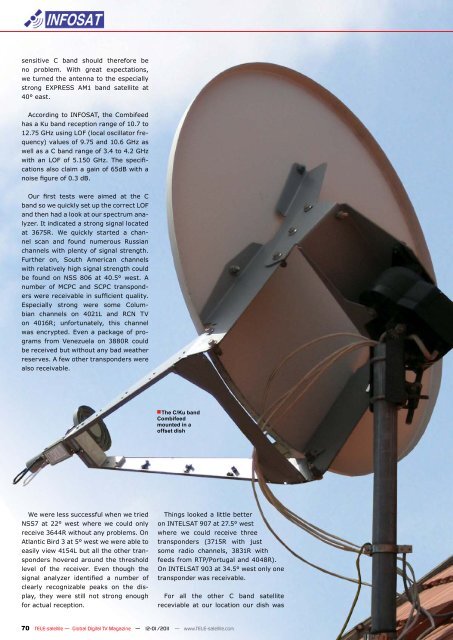TELEsatelit - TELE-satellite International Magazine
TELEsatelit - TELE-satellite International Magazine
TELEsatelit - TELE-satellite International Magazine
Create successful ePaper yourself
Turn your PDF publications into a flip-book with our unique Google optimized e-Paper software.
sensitive C band should therefore be<br />
no problem. With great expectations,<br />
we turned the antenna to the especially<br />
strong EXPRESS AM1 band <strong>satellite</strong> at<br />
40° east.<br />
According to INFOSAT, the Combifeed<br />
has a Ku band reception range of 10.7 to<br />
12.75 GHz using LOF (local oscillator frequency)<br />
values of 9.75 and 10.6 GHz as<br />
well as a C band range of 3.4 to 4.2 GHz<br />
with an LOF of 5.150 GHz. The specifications<br />
also claim a gain of 65dB with a<br />
noise figure of 0.3 dB.<br />
Our first tests were aimed at the C<br />
band so we quickly set up the correct LOF<br />
and then had a look at our spectrum analyzer.<br />
It indicated a strong signal located<br />
at 3675R. We quickly started a channel<br />
scan and found numerous Russian<br />
channels with plenty of signal strength.<br />
Further on, South American channels<br />
with relatively high signal strength could<br />
be found on NSS 806 at 40.5° west. A<br />
number of MCPC and SCPC transponders<br />
were receivable in sufficient quality.<br />
Especially strong were some Columbian<br />
channels on 4021L and RCN TV<br />
on 4016R; unfortunately, this channel<br />
was encrypted. Even a package of programs<br />
from Venezuela on 3880R could<br />
be received but without any bad weather<br />
reserves. A few other transponders were<br />
also receivable.<br />
We were less successful when we tried<br />
NSS7 at 22° west where we could only<br />
receive 3644R without any problems. On<br />
Atlantic Bird 3 at 5° west we were able to<br />
easily view 4154L but all the other transponders<br />
hovered around the threshold<br />
level of the receiver. Even though the<br />
signal analyzer identified a number of<br />
clearly recognizable peaks on the display,<br />
they were still not strong enough<br />
for actual reception.<br />
70 <strong>TELE</strong>-<strong>satellite</strong> — Global Digital TV <strong>Magazine</strong> — 12-01/2011 — www.<strong>TELE</strong>-<strong>satellite</strong>.com<br />
■<br />
The C/Ku band<br />
Combifeed<br />
mounted in a<br />
offset dish<br />
Things looked a little better<br />
on INTELSAT 907 at 27.5° west<br />
where we could receive three<br />
transponders (3715R with just<br />
some radio channels, 3831R with<br />
feeds from RTP/Portugal and 4048R).<br />
On INTELSAT 903 at 34.5° west only one<br />
transponder was receivable.<br />
For all the other C band <strong>satellite</strong><br />
receviable at our location our dish was

















